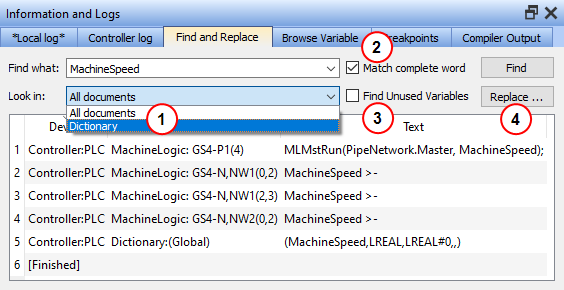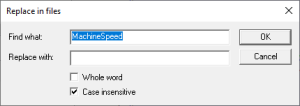Find and Replace Tab
This tab enables you to search for all the instances of a string of characters (search is not case sensitive) within the entire environment, and replace it if desired.
You can re-use one of the last ten entries or type a new text string.
| Call out# | Description |
|---|---|

|
The operation can be performed across:
|

|
The search string can be with 'complete word' only. When selected, only the instances that match the complete words defined in the "Find what" field are selected (for example, a search for "MyVar" returns "MyVar" but not "MyVariable"). When this option is selected, the search is case sensitive. |

|
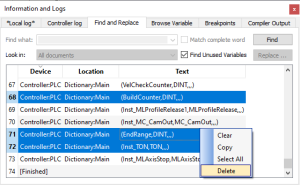 To optimize your project, the Find Unused Variables option allows you to perform a search in the dictionary to locate variables not used 1 in any program. Selecting this option and clicking Find generates a list of the unused variables. You can select one or more variables (by Shift- or Ctrl-clicking) and right-click to open the context menu. The menu includes a Delete option. Double-click a variable in the list within the table widget to open it in the Dictionary. To optimize your project, the Find Unused Variables option allows you to perform a search in the dictionary to locate variables not used 1 in any program. Selecting this option and clicking Find generates a list of the unused variables. You can select one or more variables (by Shift- or Ctrl-clicking) and right-click to open the context menu. The menu includes a Delete option. Double-click a variable in the list within the table widget to open it in the Dictionary. |

|
The replace function is limited: it is not supported in the Dictionary, Pipe Network and HMI |
Once the search is done, the results appear in the table widget at the bottom of this tab. If a replace has been performed, the Text column provides more information about the replacement.
Double-click the item you want in the list in order to open it in its relevant location (it can be a PLC![]() "Programmable Logic Controller"
A Programmable Logic Controller, PLC, or Programmable Controller is a digital computer used for automation of industrial processes, such as control of machinery on factory assembly lines.
Used to synchronize the flow of inputs from (physical) sensors and events with the flow of outputs to actuators and events editor or the Dictionary).
"Programmable Logic Controller"
A Programmable Logic Controller, PLC, or Programmable Controller is a digital computer used for automation of industrial processes, such as control of machinery on factory assembly lines.
Used to synchronize the flow of inputs from (physical) sensors and events with the flow of outputs to actuators and events editor or the Dictionary).

- Controller : PLC and MachineLogic refer to the program in the Project Explorer
- GS stands for Graphical and Step (T is for Transition)
- 101 is the reference in the editor
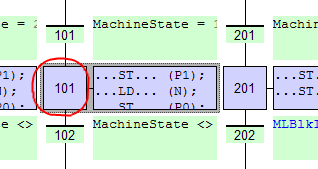
- -P1(4) refers to the P1 tab and the 4th line in the source code
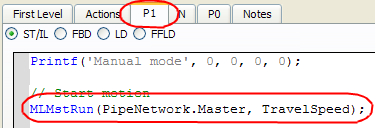
FFLD Location details

- Controller : PLC and Main refer to the program in the Project Explorer
- GS stands for Graphical and Step (T is for Transition)
- 5 is the reference in the editor
- -N refers to the N tab
- NW15 stands for Network number 15
- (4,2) correspond to the X,Y coordinates of the cell relative to the current network

ST![]() "Structured text"
A high-level language that is block structured and syntactically resembles Pascal Location details
"Structured text"
A high-level language that is block structured and syntactically resembles Pascal Location details

- Controller : PLC and MyST_function refer to the program in the Project Explorer
- (5) refers to the 5th line in the source code
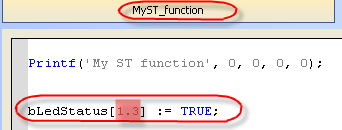
For more details, see "Find and Replace Operations".
